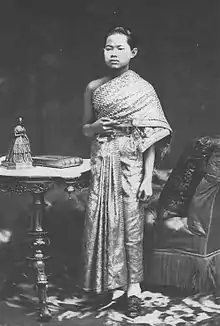Panung
The panung or pha nung (Thai: ผ้านุ่ง, RTGS: pha nung, pronounced [pʰâː nûŋ]) is a lower attire worn by individuals from Siam.

Style
Panung is a traditional garment worn in Thailand.[1] It is a long strip of cloth, described in 1921 by the US vice-consul as "a piece of cotton cloth 3 by 10 feet"[1] is wrapped around the waist, reaching below the knees. The cloth is sometimes passed between the legs and tucked at the back[2] in a fashion known as chong kraben or pha chung hang. The garment is normally paired with a pha biang or pha hom, a similar cloth used to cover the upper body.[1]
Variations
Panung is a versatile garment that can be worn by anyone, regardless of gender. It is available in different qualities, with first quality being Patta. Patta is a durable printed cloth that features bold check patterns or with cross designed patterns. It is possible for this item to have one or more stripes at either end.[3] The second quality is Papoon, characterized by fast coloration and the narrow stripes woven into the cloth.[3] It is also woven with a two-and-two checking pattern.[4] The third quality is known as Palai, which refers to proper sizing of materials and a stiffened structure.[3]
Contemporary Western clothing is moving away from the traditional Panung style of dressing.[5]
Images

 Queen Somanass Waddhanawathy, a first queen of King Mongkut (Rama IV) wearing pha nung and pha biang
Queen Somanass Waddhanawathy, a first queen of King Mongkut (Rama IV) wearing pha nung and pha biang


 Queen Savang Vadhana, a consort of King Chulalongkorn (Rama V) wearing pha nung and pha biang, in 1879
Queen Savang Vadhana, a consort of King Chulalongkorn (Rama V) wearing pha nung and pha biang, in 1879
 Thai children wearing pha nung and pha biang
Thai children wearing pha nung and pha biang.jpg.webp)
References
- Hansen, Carl C (11 April 1921). "Market for Ready-Made Clothing in Siam". Commerce Reports. Bureau of Foreign and Domestic Commerce, Department of Commerce. 2 (83): 226.
- "panung | Definition of panung in English by Oxford Dictionaries". Oxford Dictionaries | English. Archived from the original on July 25, 2018. Retrieved 2018-07-24.
- Commerce Reports. Bureau of Foreign and Domestic Commerce, Department of Commerce. 1915. p. 574.
- "The Project Gutenberg eBook of Piece Goods Manual, by A. E. Blanco". www.gutenberg.org. Retrieved 2023-08-13.
- The Journal of the Siam Society. The Society. 1951. p. 218.